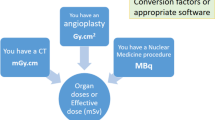Abstract
Although many efforts have been made to reduce the radiation dose associated with individual medical imaging examinations to “as low as reasonably achievable,” efforts to ensure such examinations are performed only when medically indicated and appropriate are equally if not more important. Variations in the use of ionizing radiation for medical imaging are concerning, regardless of whether they occur on a local, regional or national basis. Such variations among practices can be reduced with the use of decision support tools at the time of order entry. These tools help reduce radiation exposure among practices through the appropriate use of medical imaging. Similarly, adoption of best practices among imaging facilities can be promoted through tracking the radiation exposure among imaging patients. Practices can benchmark their aggregate radiation exposures for medical imaging through the use of dose index registries. However several variables must be considered when contemplating individual patient dose tracking. The specific dose measures and the variation among them introduced by variations in body habitus must be understood. Moreover the uncertainties in risk estimation from dose metrics related to age, gender and life expectancy must also be taken into account.
Similar content being viewed by others
References
Brink JA (2014) Dose tracking and rational exam selection for the medically-exposed population. Health Phys 106:225–228
New York Times (2011) Hospitals perform needless double CT scans, records show. 18 June 2011, p 1
American College of Radiology (2013) About the ACR appropriateness criteria. http://www.acr.org/Quality-Safety/Appropriateness-Criteria/About-AC. Accessed 20 June 2013
Government of Western Australia, Department of Health (2013) A clinical decision support tool and educational resource for diagnostic imaging. http://www.imagingpathways.health.wa.gov.au. Accessed 13 April 2013
Berland LL, Silverman SG, Gore RM et al (2010) Managing incidental findings on abdominal CT: white paper of the ACR incidental findings committee. J Am Coll Radiol 7:754–773
Berland LL, Silverman SG, Megibow AJ et al (2014) ACR members’ response to JACR white paper on the management of incidental abdominal CT findings. J Am Coll Radiol 11:30–35
Hendee WR, Becker GJ, Borgstede JP et al (2010) Addressing overutilization in medical imaging. Radiology 257:240–245
Sistrom CL, Dang PA, Weilburg JB et al (2009) Effect of computerized order entry with decision support on the growth of outpatient procedure volumes: seven-year time series analysis. Radiology 251:147–155
Blackmore CC, Mecklenburg RS, Kaplan GS (2011) Effectiveness of clinical decision support in controlling inappropriate imaging. J Am Coll Radiol 8:19–25
Boland GWL, Thrall JH, Gazelle GS et al (2011) Decision support for radiologist report recommendations. J Am Coll Radiol 8:819–823
Hendee WR, O’Connor MK (2012) Radiation risks of medical imaging: separating fact from fantasy. Radiology 264:312–321
Israel GM, Cicchiello L, Brink JA et al (2010) Patient size and radiation exposures in thoracic, pelvic, and abdominal CT examinations performed with automatic exposure control. AJR Am J Roentgenol 195:1342–1346
(2011) AAPM 204 -- Size-specific dose estimates (SSDE) in pediatric and adult body CT examinations. Report of AAPM Task Group 204. American Association of Physicists in Medicine, College Park, MD
(2013) Sources, effects and risks of ionizing radiation. UNSCEAR 2013 report, volume 2, Scientific NXB effects of radiation exposure in children. Available via http://www.unscear.org/en/publications/2013_2.html. Accessed 21 April 2014
Committee to Assess Health Risks from Exposure to Low Levels of Ionizing Radiation, National Research Council (2005) Health risks from exposure to low levels of ionizing radiation -- BEIR VII. National Academies Press, Washington, DC
Shuryak I, Sachs RK, Brenner DJ (2010) Cancer risks after radiation exposure in middle age. J Natl Cancer Inst 102:1628–1636
Brenner DJ, Shuryak I, Einstein AJ (2011) Impact of reduced patient life expectancy on potential cancer risks from radiologic imaging. Radiology 261:193–198
Bankier AA, Kressel HY (2012) Through the looking glass revisited: the need for more meaning and less drama in the reporting of dose and dose reduction in CT. Radiology 265:4–8
Mahajan A, Starker LF, Ghita M et al (2012) Parathyroid 4DCT: evaluation of radiation dose exposure during preoperative localization of parathyroid tumors in primary hyperparathyroidism. World J Surg 36:1335–1339
Conflicts of interest
Dr. Brink has no financial interests, investigational or off-label uses to disclose.
Author information
Authors and Affiliations
Corresponding author
Rights and permissions
About this article
Cite this article
Brink, J.A. Clinical decision-making tools for exam selection, reporting and dose tracking. Pediatr Radiol 44 (Suppl 3), 418–421 (2014). https://doi.org/10.1007/s00247-014-3015-z
Received:
Revised:
Accepted:
Published:
Issue Date:
DOI: https://doi.org/10.1007/s00247-014-3015-z




